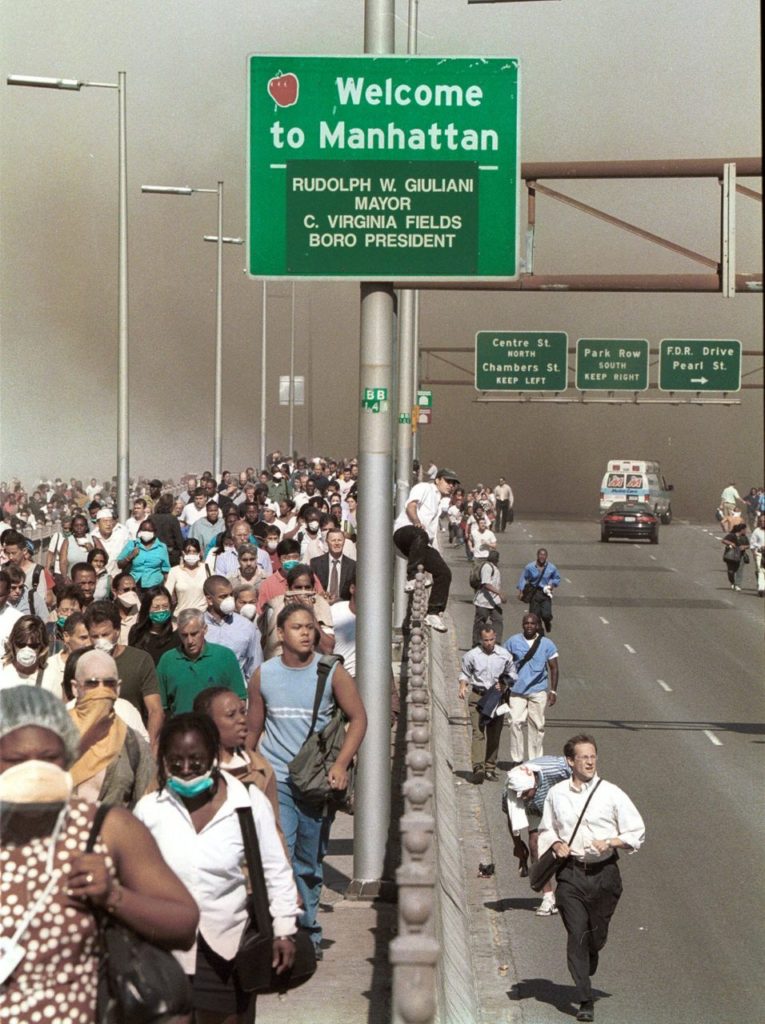composition 2- 9/11 pictures
1. Rule of thirds
~ position the most important elements in your scene along these lines, or at the points where they intersect.

This picture shows rule of thirds because the main subject to the side and the scene goes along this the lines. The towers also meet at one of the lines points.
2. Balancing Elements (balance)
~Placing your main subject off-centre, as with the rule of thirds, creates a more interesting photo, but it can leave a void in the scene which can make it feel empty. You can achieve a balanced composition and even out the main subject's "visual weight" by including another object of lesser importance to fill the space.

This pictures shows Balancing Elements because the main subject is off center and the people make lines to the dust in the back of the burning towers.
3. Leading Lines (lines)
~you can affect the way we view the image, pulling us into the picture, towards the subject, or on a journey "through" the scene.There are many different types of line - straight, diagonal, curvy, zigzag, radial etc - and each can be used to enhance our photo's composition.

This photo shows Leading lines because the pieces of the building make lines that lead to the crumbling building.
4. Symmetry and Patterns (repetition)
~Another great way to use them is to break the symmetry or pattern in some way, introducing tension and a focal point to the scene.

This photo shows symmetry because of the symmetrical buildings and the bridge.
5. Viewpoint
~Rather than just shooting from eye level, consider photographing from high above, down at ground level, from the side, from the back, from a long way away, from very close up, and so on.

This photo shows viewpoint because it attracts you to the American flag still standing while the twin towers are collapsing in the background.
6. Background (simplicity)
~look around for a plain and unobtrusive background and compose your shot so that it doesn't distract or detract from the subject.

This photo shows background due the sun pulling you into the twin towers and the background doesn't take away from the photo.
7. Create depth
~You can create depth in a photo by including objects in the foreground, middle ground and background.
 This photo creates depth through the levels from the memorial to the ground zero buildings.
This photo creates depth through the levels from the memorial to the ground zero buildings.
8. Framing
~The world is full of objects which make perfect natural frames, such as trees, archways and holes. By placing these around the edge of the composition you help to isolate the main subject from the outside world. The result is a more focused image which draws your eye naturally to the main point of interest.

This photo shows framing since the trees are surrounding one of the twin towers.
9. Cropping
~By cropping tight around the subject you eliminate the background "noise", ensuring the subject gets the viewer's undivided attention.

This photo shows cropping since the bottom of the towers and the city is cropped out.
10. Mergers and avoiding them

This photo shows a merger since the building looks like its growing out of his back and head. To avoid it the photograph could've moved over and just got the guy and the building.
~ position the most important elements in your scene along these lines, or at the points where they intersect.

This picture shows rule of thirds because the main subject to the side and the scene goes along this the lines. The towers also meet at one of the lines points.
2. Balancing Elements (balance)
~Placing your main subject off-centre, as with the rule of thirds, creates a more interesting photo, but it can leave a void in the scene which can make it feel empty. You can achieve a balanced composition and even out the main subject's "visual weight" by including another object of lesser importance to fill the space.

This pictures shows Balancing Elements because the main subject is off center and the people make lines to the dust in the back of the burning towers.
3. Leading Lines (lines)
~you can affect the way we view the image, pulling us into the picture, towards the subject, or on a journey "through" the scene.There are many different types of line - straight, diagonal, curvy, zigzag, radial etc - and each can be used to enhance our photo's composition.

This photo shows Leading lines because the pieces of the building make lines that lead to the crumbling building.
4. Symmetry and Patterns (repetition)
~Another great way to use them is to break the symmetry or pattern in some way, introducing tension and a focal point to the scene.

This photo shows symmetry because of the symmetrical buildings and the bridge.
5. Viewpoint
~Rather than just shooting from eye level, consider photographing from high above, down at ground level, from the side, from the back, from a long way away, from very close up, and so on.

This photo shows viewpoint because it attracts you to the American flag still standing while the twin towers are collapsing in the background.
6. Background (simplicity)
~look around for a plain and unobtrusive background and compose your shot so that it doesn't distract or detract from the subject.
This photo shows background due the sun pulling you into the twin towers and the background doesn't take away from the photo.
7. Create depth
~You can create depth in a photo by including objects in the foreground, middle ground and background.
8. Framing
~The world is full of objects which make perfect natural frames, such as trees, archways and holes. By placing these around the edge of the composition you help to isolate the main subject from the outside world. The result is a more focused image which draws your eye naturally to the main point of interest.

This photo shows framing since the trees are surrounding one of the twin towers.
9. Cropping
~By cropping tight around the subject you eliminate the background "noise", ensuring the subject gets the viewer's undivided attention.

This photo shows cropping since the bottom of the towers and the city is cropped out.
10. Mergers and avoiding them

This photo shows a merger since the building looks like its growing out of his back and head. To avoid it the photograph could've moved over and just got the guy and the building.
Comments
Post a Comment